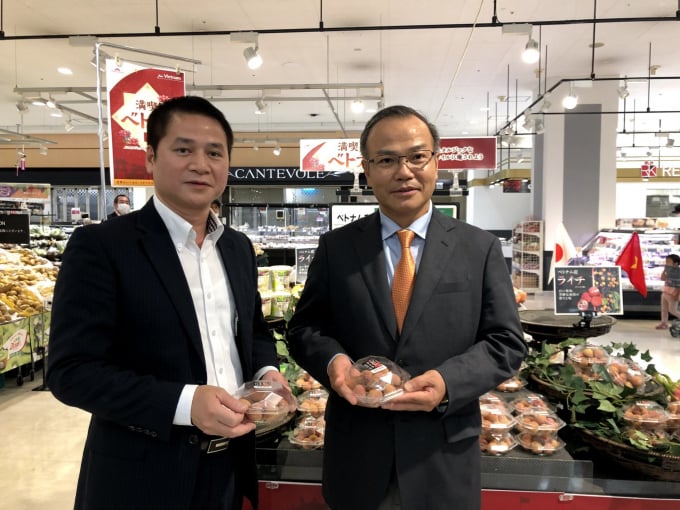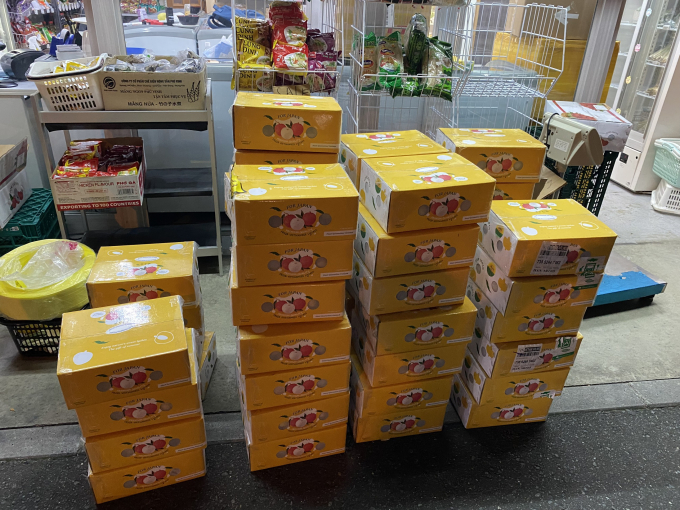September 27, 2025 | 09:19 GMT +7
September 27, 2025 | 09:19 GMT +7
Hotline: 0913.378.918
September 27, 2025 | 09:19 GMT +7
Hotline: 0913.378.918

Thieu lychee will be introduced at Vietnamese Festival in Tokyo.
On December 15, 2019, Japanese Government made a decision of importing Vietnamese “Thieu” lychee. Since then, the export volume of this fruit to Japan has increased steadily year by year.
In 2020 alone, 40 tons of fresh lychees were imported by Japan. In 2021, the volume increased by 10 times, reaching 300-400 tons and the figure is expected to continue to rise this year.
The reason for the initial success of Vietnamese fresh lychee exports to Japan is that lychee is among imported fruits that Japanese consumers most look forward to in the summer.
In order to further promote the image of Vietnamese fresh lychee, Vietnam Trade Office in Japan will hold an event to introduce fresh lychee at Vietnamese Festival 2022 which is going to take place in Tokyo from June 4-5, 2022 coincided with the harvest of the main-crop lychees.

Lychee Display Stand is set up at Vietnamese Festival 2022 in Tokyo.
Vietnamese Festival in Tokyo has become an annual event and has been held by Vietnamese Embassy to Japan since 2008. It’s as part of the campaign to promote the image of Vietnam in Japan; thereby contributing to enhancing cultural exchange, and mutual understanding between the two countries.
In 2021, enterprises and organizations set up 40 display stands at the festival and the event attracted around 30,000 visitors.
The new feature of the festival this year is that Vietnam Trade Office in Japan cooperated with the People Committee of Bac Giang province and two enterprises including Ameii Vietnam Joint Stock Company and Global Export and Import Foodstuff Joint Stock Company to introduce Vietnamese fresh lychee directly to visitors. Attending the event, visitors will have the opportunity to experience and taste fresh lychees.
“The festival this year will contribute to advertising Vietnamese fresh lychee and making the fruit become more and more popular for Japanese consumers,” a Representative of Vietnam Trade Office in Japan said.

The first batches of “Thieu” lychee are ready to be present at the festival.
In the two lychee crops of 2020 and 2021, Vietnamese fresh lychee entered the Japanese market successfully with export volume in the first year reaching 40 tons and the figure continued to increase in the subsequent year.
Vietnamese lychee has won the hearts of most of the Japanese consumers, especially Vietnamese community living, studying and working in Japan.
According to Vietnam Trade Office in Japan, the batches of early-ripening lychees from the provinces of Hai Duong and Bac Giang have arrived in Japan by air. Several months earlier, the businesses of the two countries exchanged information and came to an agreement on the plans of transporting Vietnamese lychees to Japan in the 2022 crop.
Like many other countries, Japan has strict rules of food safety and sanitation restricting the entry of foreign food and drink products. In 2022, the country introduced the requirement for testing antibiotics residues for the shipments of Vietnamese lychees.
Vietnam Trade Office in Japan notified the domestic businesses about the information and quickly gave recommendations to lychee producers and exporters so that they can ensure the quality of lychee and meet increased demand of the Japanese market.

“Thieu” lychees exported to Japan have traceability with QR Codes.
In tandem with improving the quality and value of the product, Vietnamese companies and their Japanese partners announced enhanced cooperation on transferring new preservation technologies to keep lychees fresh longer.
The inspections of the quality of fresh lychees will be implemented in all stages from planting, caring for to harvesting. Especially, after harvesting, lychees will be preliminarily processed within 3 hours to maintain fruit freshness and taste.
At the festival this year, Vietnamese lychees are packaged in bags for 1 kilo, 2 kilos or 5 kilos in order to meet the diverse needs of customers from individuals who buy for personal consumption to those who buy the fruit as gifts for their friends, relatives or partners.
According to the General Department of Customs under the Ministry of Finance, Vietnam’s exports to Japan reached US$7.4 billion in the first four months of 2022, up 11.7% from the same period in 2021. Particularly, the export of agricultural, fishery products reached US$678.2 million, an increase of 17.6% over the same period last year.
The main export products of Vietnam include: Seafood (reaching US$490.2 million, up 14%); Coffee (reaching US$110.1 million, up 45.4%); Vegetables & Fruits (reaching US$50.1 million, up 7.5%); Cashew (reaching US$15.8 million, up 7%); Pepper (reaching US$6.5 million, up 121%); Rubber (reaching US$5.4 million, down 13.3%)
Translated by Mai Tham

(VAN) Vietnam's fruit and vegetable exports hit a new milestone in August, reaching over USD 951 million, the highest monthly figure ever recorded for the sector.

(VAN) Facing barriers from major markets such as the US and the EU, Vietnam’s tuna enterprises are striving to find new markets.

(VAN) High yields lead to high nutrient removal rates, but next year, nutrient replacement and feeding a new crop comes at a higher cost.
/2025/09/17/4524-1-142258_778.jpg)
(VAN) A 50% reciprocal tariff imposed by the U.S. has pushed India's shrimp industry into crisis. Vietnamese shrimp could increase market share and seize the opportunity to promote its image as safe and sustainable.

(VAN) Mr. Nguyen Hong Dien, Vietnam’s Minister of Industry and Trade, sent a letter to the U.S. Secretary of Commerce, urging an objective review of seafood trade.

(VAN) Organic coffee farms in the Central Highlands have reached global markets, carrying with them the sweetness of the red basalt soil and the inspiring story of positive change for the local communities.
/2025/09/16/3618-anh-4-232727_78.jpg)
(VAN) In the first eight months of 2025, Dong Thap's exports have made a spectacular breakthrough. Particularly, rice exports achieved outstanding growth, bringing practical benefits to farmers.